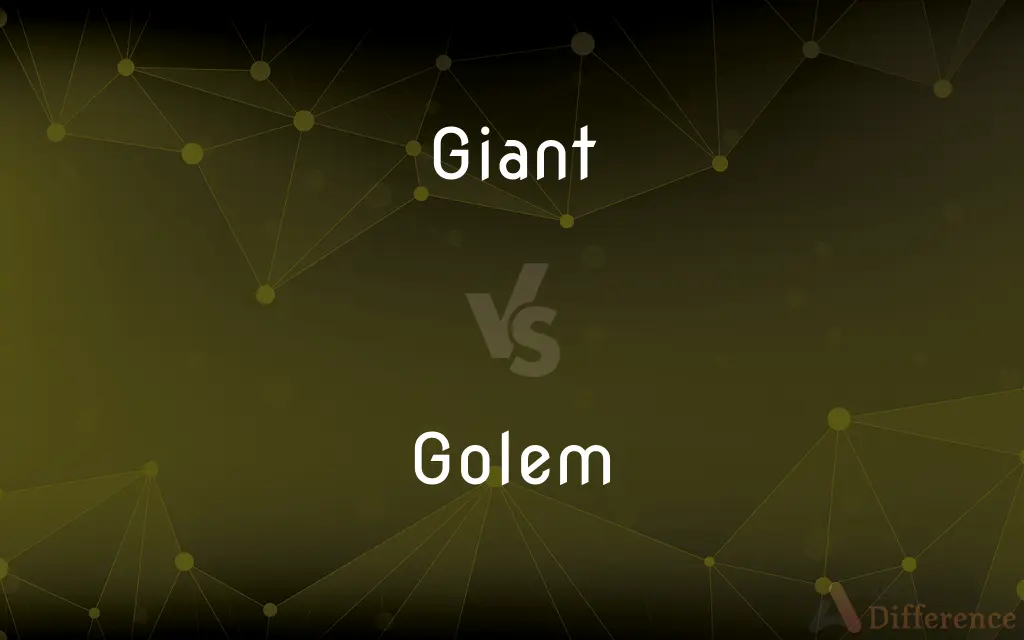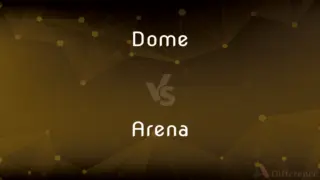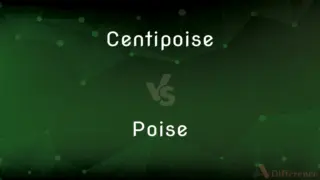Giant vs. Golem — What's the Difference?
By Urooj Arif & Fiza Rafique — Updated on April 18, 2024
Giant refers to a mythical being of enormous size and strength, common in folklore, while a golem is a creature from Jewish folklore made from inanimate matter, often clay, animated to serve.

Difference Between Giant and Golem
Table of Contents
ADVERTISEMENT
Key Differences
Giants are typically depicted as human-like beings with extraordinary size and strength, appearing in various mythologies and stories. In contrast, golems are created from inanimate material like clay or mud and are brought to life through magical rituals and symbols in Jewish folklore.
Giants often play roles as antagonists or challenges for heroes in myths, symbolizing overwhelming natural forces or obstacles. On the other hand, golems are usually depicted as servants or protectors, created to perform specific tasks or protect a community, reflecting themes of control over the material world.
The creation of a giant is generally not described in detail in folklore; they are often natural or supernatural beings. Whereas, the creation of a golem is a deliberate act, involving mystic rituals and spells, emphasizing the themes of creation and the limits of human control.
Giants in mythology are often autonomous and endowed with their own wills and desires, capable of independent thought and action. In contrast, golems are typically bound to the will of their creator, lacking free will and operating under strict obedience, which underscores themes of servitude and autonomy.
In popular culture, giants are frequently shown as both monstrous and majestic, participating in epic battles or as solitary creatures. On the other hand, golems are often portrayed in literature and film as tragic figures, their existence tied to the purpose for which they were created, which highlights the ethical implications of creating life.
ADVERTISEMENT
Comparison Chart
Origin
Various mythologies (Norse, Greek)
Jewish folklore
Material
Imaginary, not specific to any material
Made from clay or mud
Autonomy
Often independent with free will
Bound to the creator’s commands
Role
Often antagonists, challenges for heroes
Protectors, servants
Creation
Born or appear naturally
Created through rituals and spells
Compare with Definitions
Giant
An influential, powerful company.
The tech giant announced groundbreaking innovations at the summit.
Golem
An entity crafted as a protector but lacking free will.
The golem followed the commands without question, its purpose singular.
Giant
A mythical being of enormous size and strength.
The giant roamed the mountains, feared by all villagers.
Golem
A creature from Jewish folklore made from clay, brought to life to serve.
The golem was created to protect the village from invaders.
Giant
A person or thing of unusually large size.
The skyscraper stood like a giant among the downtown buildings.
Golem
A metaphor for soulless labor or automated functions.
The factory workers were treated as mere golems, expected to perform tirelessly.
Giant
An exceptionally large animal or plant.
The giant sequoia trees are some of the oldest living organisms on Earth.
Golem
A figure or entity that is robot-like or lacks emotion.
He moved through his routine like a golem, without passion.
Giant
Something extraordinary or unusually large.
The discovery was a giant leap for the scientific community.
Golem
A being or creature created by man and magically given life.
In the story, the wizard crafted a golem to guard his treasures.
Giant
In folklore, giants (from Ancient Greek: gigas, cognate giga-) are beings of human-like appearance, but are at times prodigious in size and strength or bear an otherwise notable appearance. The word giant is first attested in 1297 from Robert of Gloucester's chronicle.
Golem
A golem ( GOH-ləm; Hebrew: גולם) is an animated anthropomorphic being in Jewish folklore that is created entirely from inanimate matter (usually clay or mud). The word was used to mean an amorphous, unformed material in Psalms and medieval writing.The most famous golem narrative involves Judah Loew ben Bezalel, the late-16th-century rabbi of Prague.
Giant
A person or thing of great size.
Golem
In Jewish folklore, an artificially created human supernaturally endowed with life.
Giant
A person or thing of extraordinary power, significance, or importance
A giant in the field of physics.
Automotive industry giants.
Golem
(mythology) A humanoid creature made from clay, animated by magic.
Giant
Greek Mythology One of a race of humanlike beings of enormous strength and stature who were destroyed in battle with the Olympians.
Golem
A humanoid creature made from any previously inanimate matter, such as wood or stone, animated by magic.
Giant
A being in folklore or myth similar to one of these beings.
Golem
(Jewish folklore) an artificially created human being that is given life by supernatural means
Giant
A gymnastic maneuver in which the body is swung, fully extended, around a horizontal bar.
Golem
A mechanism that can move automatically
Giant
Marked by exceptionally great size, magnitude, or power
A giant wave.
A giant impact.
Giant
A mythical human of very great size.
Giant
(mythology) Specifically:
Giant
Any of the gigantes, the race of giants in the Greek mythology.
Giant
A jotun.
Giant
A very tall and large person.
Giant
A tall species of a particular animal or plant.
Giant
(astronomy) A star that is considerably more luminous than a main sequence star of the same temperature (e.g. red giant, blue giant).
Giant
(computing) An Ethernet packet that exceeds the medium's maximum packet size of 1,518 bytes.
Giant
A very large organisation.
The retail giant is set to acquire two more struggling high-street chains.
Giant
A person of extraordinary strength or powers, bodily or intellectual.
Giant
(gymnastics) A maneuver involving a full rotation around an axis while fully extended.
Giant
Very large.
Giant
A man of extraordinari bulk and stature.
Giants of mighty bone and bold emprise.
Giant
A person of extraordinary strength or powers, bodily or intellectual.
Giant
Any animal, plant, or thing, of extraordinary size or power.
Giant
Like a giant; extraordinary in size, strength, or power; as, giant brothers; a giant son.
Giant
Any creature of exceptional size
Giant
A person of exceptional importance and reputation
Giant
An unusually large enterprise;
Walton built a retail giant
Giant
A very large person; impressive in size or qualities
Giant
Someone or something that is abnormally large and powerful
Giant
An imaginary figure of superhuman size and strength; appears in folklore and fair tales
Giant
A very bright star of large diameter and low density (relative to the Sun)
Giant
Of great mass; huge and bulky;
A jumbo jet
Jumbo shrimp
Common Curiosities
What is a golem?
A golem is a creature from Jewish folklore, created from inanimate material like clay, animated through mystical means to serve its creator.
What is the primary purpose of a golem in folklore?
Golems are primarily created for protection or to perform tasks, closely tied to the commands of their creator.
What is a giant?
A giant is a mythical creature often depicted as a large and powerful being, typically humanoid, found in various folklore traditions.
What are the moral implications of creating a golem?
Creating a golem often raises ethical questions about control, creation of life, and the responsibilities of the creator.
How are giants typically portrayed in stories?
Giants are often portrayed as powerful beings either as antagonists that heroes must overcome or as magnificent creatures embodying natural forces.
What materials are used to create a golem?
Golems are traditionally made from clay or mud, brought to life through mystical rituals.
Can giants and golems think and act independently?
Giants are usually capable of independent thought and action, whereas golems typically act under the orders of their creator without free will.
Are there different types of giants?
Yes, there are various types of giants in mythologies around the world, each with unique attributes and stories.
How do giants and golems differ in autonomy?
Giants act with autonomy and personal motives, while golems lack free will, existing solely to execute their creator’s orders.
What happens to a golem if it is no longer needed?
According to folklore, a golem can be deactivated by removing or altering the inscriptions that give it life, effectively returning it to inanimate clay.
Do giants have any weaknesses?
In myths, giants often have specific weaknesses that heroes exploit to defeat them, despite their great strength and size.
Can a golem speak?
Typically, golems do not speak; they are creatures of action, created to follow orders rather than engage in conversation.
In which cultural traditions are giants found?
Giants appear in numerous cultural traditions, including Norse, Greek, and Celtic mythology.
Are giants considered supernatural?
Yes, giants are often considered supernatural due to their immense size and strength, beyond normal human capabilities.
What role do giants and golems play in modern media?
Both giants and golems are popular in modern media, often depicted in fantasy films, literature, and games, each serving different narrative roles based on their mythological origins.
Share Your Discovery

Previous Comparison
Dome vs. Arena
Next Comparison
Centipoise vs. PoiseAuthor Spotlight
Written by
Urooj ArifUrooj is a skilled content writer at Ask Difference, known for her exceptional ability to simplify complex topics into engaging and informative content. With a passion for research and a flair for clear, concise writing, she consistently delivers articles that resonate with our diverse audience.
Co-written by
Fiza RafiqueFiza Rafique is a skilled content writer at AskDifference.com, where she meticulously refines and enhances written pieces. Drawing from her vast editorial expertise, Fiza ensures clarity, accuracy, and precision in every article. Passionate about language, she continually seeks to elevate the quality of content for readers worldwide.














































